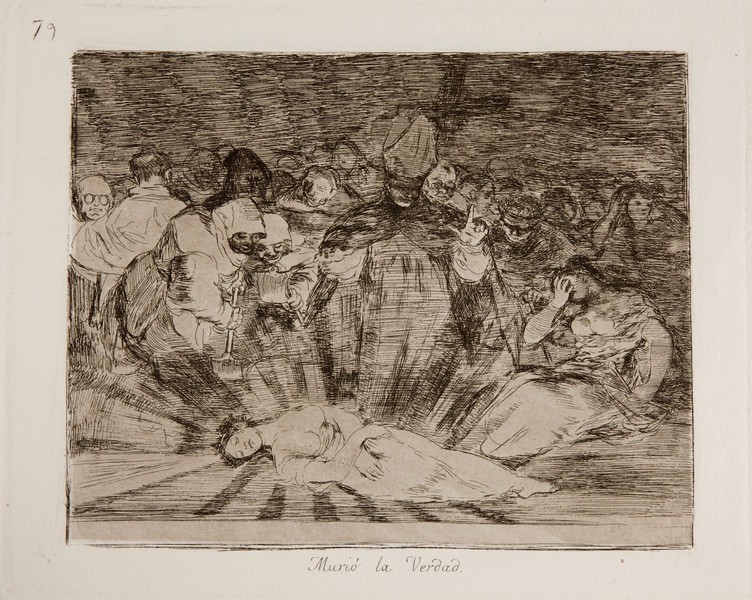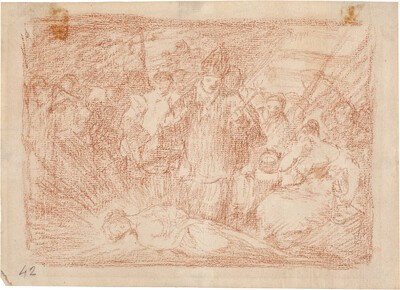- Cronología
- Ca. 1820 - 1823
- Dimensiones
- 176 x 221 mm
- Técnica y soporte
- Etching and burnisher
- Reconocimiento de la autoría de Goya
- Undisputed work
- Ficha: realización/revisión
- 06 Jan 2011 / 05 Jun 2023
- Inventario
- 225
See Sad forebodings of what is to come.
The title of the print was handwritten by Goya on the first and only series known to us at the time of its production, which the painter gave to his friend Agustín Ceán Bermúdez. Thus the title was subsequently engraved on the plate without any modification from Ceán Bermúdez's copy for the first edition of the Disasters of War published by the Royal Academy of Fine Arts of San Fernando in Madrid in 1863.
A preparatory drawing of this engraving is in the Prado Museum
In the foreground on the ground lies a bare-breasted female figure, which could be an allegory of Truth, as the title suggests, from which rays of light emanate. She is surrounded by several people attending her burial; a bishop seems to be officiating and monks with shovels are preparing to bury the body. On the left is the allegory of Justice, holding the scales with one hand and covering her face with the other in mourning; she is the saddest figure in this scene.
This is not the first time that Goya refers to the allegory of Justice in the series of The Disasters of War, as it is also found in engraving no. 69, Nothing. This will tell us that in his first state proof its presence was quite clear.
In some cases it has been suggested that the woman being buried could be the Constitution, wearing a laurel wreath alluding to her victory. The rays she emanates indicate that she could still be alive and that she is resisting burial. In this way, as Jesusa Vega points out, Goya's image could be an illustration of the events that took place in Madrid that have been described in the Manifesto of everything that happened in Madrid on the occasion of the King's Decree of 4 May: namely the abrogation of the Constitution, the solemnity with which the tombstone of that name in the Plaza Mayor was dragged, the burning in the same square of the statue of Liberty; and also a compilation of the functions that took place in Madrid on the occasion of the entry of our august Monarch Ferdinand VII, published in the Madrid printing house of the Viuda de Vallín in 1814. In addition, the décima A la caída de la Constitución y muerte de los liberales On the Fall of the Constitution and the Death of the Liberals was distributed on flyleaves.
Another possible source of inspiration for engraving no. 79 is, as Nigel Glendinning suggests, the work of Giambattista Casti (Viterbo or Acquapendente, 1724-Paris, 1803) Gli animali parlanti (1801). The historian believes that Truth Died may have to do with Canto XIV, in which Justice and Truth disappear from the earth.
This image has some parallels with several pages in Notebook C, especially with C.117 Lux Ex Tenebris. In it, Goya wanted to show that, despite the absolutists' attempts to bury the Constitution, it, with its glowing body, augurs its imminent resurrection.
The somewhat hermetic nature of most of the prints in the Emphatic Caprices makes their identification rather complex. In many cases, as in Died the Truth, it could be thought that Goya condenses several ideas into a single print, drawing on various sources of inspiration.
The plate is in the National Chalcography (cat. 330).
-
Goya and his timesThe Royal Academy of ArtsLondon1963cat. 66cat. 254
-
De grafiek van GoyaRijksmuseum RijksprentenkabinetAmsterdam1970from November 13th 1970 to January 17th 1971cat. 89
-
Goya. Das Zeitalter der Revolucionen. Kunst um 1800 (1980 – 1981)Hamburger KunsthalleHamburg1980cat. 105
-
Francisco de GoyaMuseo d'Arte ModernaLugano1996exhibition celebrated from September 22nd to November 17th.p.196, cat. 79
-
Francisco Goya. Sein leben im spiegel der graphik. Fuendetodos 1746-1828 Bordeaux. 1746-1996Galerie KornfeldBern1996from November 21st 1996 to January 1997cat. 169
-
Francisco Goya. Capricci, follie e disastri della guerraSan Donato Milanese2000Opere grafiche della Fondazione Antonio Mazzottacat. 159
-
Goya en tiempos de guerraMuseo Nacional del PradoMadrid2008consultant editor Manuela B. Mena Marqués, from April 14th to July 13th 2008cat. 118
-
Goya et la modernitéPinacothèque de ParisParís2013from October 11st 2013 to March 16th 2014cat. 118
-
Goya: Order and disorderMuseum of Fine ArtsBoston2014cat. 187
-
2022
-
Goya, grabadorMadridBlass S.A.1918cat. 181
-
Goya engravings and lithographs, vol. I y II.OxfordBruno Cassirer1964cat. 199
-
Vie et ouvre de Francisco de GoyaParísOffice du livre1970cat. 1132
-
A solution to the enigma of Goya’s emphatic caprices nº 65-80 of The Disasters of WarApollo1978pp.186-191
-
Goya y el espíritu de la IlustraciónMadridMuseo del Prado1988cat. 161
-
Catálogo de las estampas de Goya en la Biblioteca NacionalMadridMinisterio de Educación y Cultura, Biblioteca Nacional1996cat. 304
-
Dibujos de Goya: Los álbumesBarcelonaNoguer1973
-
El Libro de los Desastres de la GuerraMadridMuseo del Prado2000pp.137-159
-
ParísPinacoteca de París2013p. 159
-
Goya: Order & DisorderBostonMuseum of Fine Arts Boston Publications2014p. 281
-
Goya. In the Norton Simon MuseumPasadenaNorton Simon Museum2016pp. 114-151
-
Museo de Bellas Artes de Badajoz y Diputación de Badajoz2022p. 86

